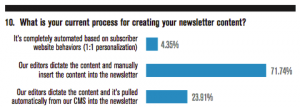Word of mouth is one of the most effective (and least expensive) ways to get more exposure, more awareness, and ultimately more customers for your business. Even with the most costly advertising campaign, you won’t see a return on your investment if it doesn’t get people talking to each other and sharing with their social networks.
But how can you as a marketer or a small business owner guarantee that your content or your campaign will catch on? Well, there are no guarantees in marketing, but you can certainly set yourself up for success by taking advantage of some wisdom accumulated by the experts. One such expert is professor and author Jonah Berger, who specializes in viral marketing, trends, and social media. We recently had the opportunity to hear Jonah speak, and picked up a great framework for thinking about creating viral content. We’ll take a closer look at these principles, which Jonah calls STEPPS in his recent book, Contagious: Why Things Catch On.
The keys to contagious #content from @j1berger #Spark15 pic.twitter.com/OpGlz38O9U
— Pagemodo (@Pagemodo) October 8, 2015
Tweet we created with Post Designer during Jonah’s presentation
STEPPS to Contagious Content:
Social Currency
People love to share things that help them collect more social currency. These are secrets, little-known facts, hidden gems, and anything else that will make them seem cutting edge and in-the-know. If you can offer up something remarkable that will allow your followers to impress their network, you greatly improve your chances of getting your content shared.
Triggers
Especially if you’re a small business owner, you will never be able to afford enough ad spots to make people think of you on a regular basis. As Berger points out, top-of-mind means tip-of-tongue, so your challenge is to be top-of-mind as frequently as possible so people will talk about you regularly. One way to do this is to associate your brand with a time of day, a day of the week, or a behavior. Can you ever have a big glass of milk without thinking of an Oreo, or vice versa? When the power went out at the Super Bowl in 2013, Oreo’s winning tweet didn’t even have to mention milk, because everyone knows what you dunk an Oreo in. Point being, people drink a lot of milk – that’s a lot of opportunities for people to think (and talk) about Oreo.
Power out? No problem. pic.twitter.com/dnQ7pOgC
— Oreo Cookie (@Oreo) February 4, 2013
Oreo’s famous real-time marketing Super Bowl tweet
Emotion
You might have the most fully-featured product ever created, but the sad truth is that people don’t really want to hear about features. And if they don’t want to hear about it, they know their friends don’t either. If you want people to spread the word about what you’re promoting, find ways to tie it to an emotion. One of my personal favorite emotional campaigns right now is Uber’s series of videos showing the real-life stories of the people who drive for them, and how it has changed their lives for the better. Nowhere in those videos does Uber explain to me how taking one of their cars is better than hailing a taxi, but they have greatly strengthened my attachment to the brand, and I’ve shared a number of them with my network.
Uber’s YouTube campaign
Public
The more visible something is, the more likely people are to think and talk about it. A great example of this is Christian Louboutin’s signature red-bottom shoes. By creating a consistent, noticeable feature and attaching that to the brand, suddenly his shoes stand out in a crowd – literally. This has something in common with the first principle of social currency. Not everyone knows that red soles = Christian Louboutin, so when we notice that someone is wearing them, we’re excited to nudge a friend and point them out, indicating that we know about something that carries some exclusivity.
Who else was excited to notice Carrie’s Louboutins in the Sex and The City movie? Via PrettyProtea
Practical Value
Offering something valuable is a great way to endear people to your brand, but it’s also a great way to get people to share something with your name on it. This is the whole point of content marketing, really. Provide something that’s genuinely valuable or helpful, and people will be much more inclined to pass it on – and give you credit for it! For example, the video below from SAVEUR Magazine is a 1 minute tutorial about peeling garlic, and it has over 3.5 million views. In fact, I remember sharing it on my own Facebook page!
Via SAVEUR on YouTube
Stories
This final principle requires a little creativity. Berger encourages us to build a story that serves as a ‘Trojan Horse’ for our brands. Because people love to tell stories, we have the opportunity to create a narrative that’s worth telling, and carve out a place in it for our brands, so that the two will travel together. Testimonials are a great resource for this. Find a customer of yours with a great story to tell, and help them share it with the world in a way that includes (but does not focus on) your brand.
Have you created a campaign that employs one of more of the STEPPS explained above? If so, we’d love to hear about it in the comments section!
Digital & Social Articles on Business 2 Community(81)









